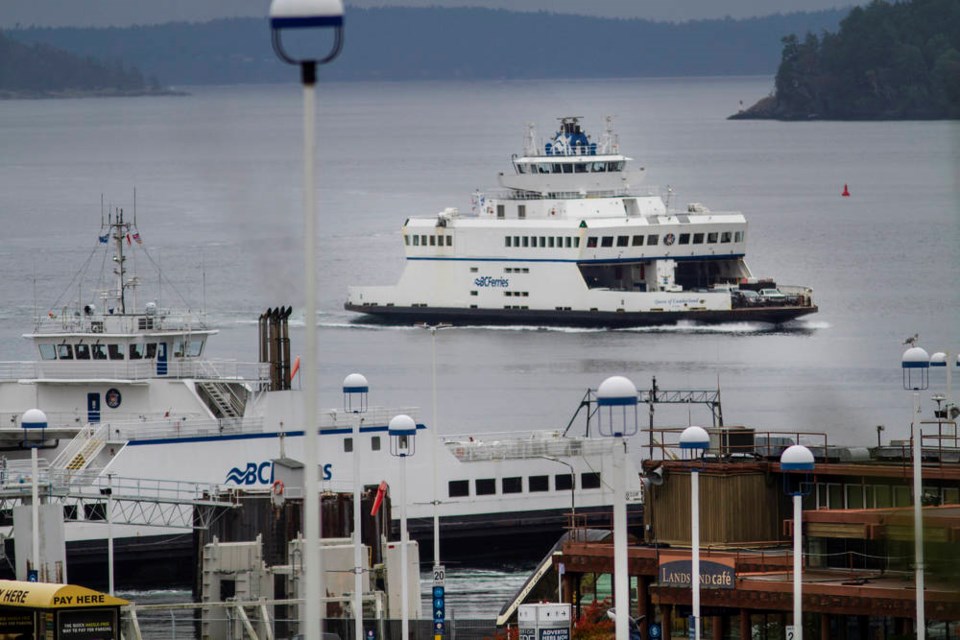With a new, bigger ship coming, B.C. Ferries is asking residents of the southern Gulf Islands how they think the schedule should be changed.
After that, the corporation will take on something less contentious, like redrawing the borders in the Middle East, or deciding who should be last in line for the vaccine.
Good lord, do they really want to open this can of worms again? Getting five islands to share a boat is like getting five drivers, each with a different destination, to share a car. Asking Gulf Islanders to draw up a ferry schedule is like asking your kids to write your will — you end up with everybody competing for the silverware, or at least the sailing that won’t make them overnight in Victoria if they have a late hospital appointment.
What B.C. Ferries has announced is a plan to consult users this spring before introducing a new Salish-class vessel on the routes linking Salt Spring, Pender, Mayne, Galiano, Saturna, Tsawwassen and Swartz Bay in 2022. (Note that this does not include the ferry that shuttles back and forth between Swartz Bay and Fulford Harbour.)
This takes gumption, given that there are ferry officials who still wake up screaming six years after the last time they tinkered with the timetable — which, on the islands in question, is like messing with a diver’s air supply.
This is something those of us on the big island don’t always appreciate, how intimately life on the little islands is tied to the rhythm of the ferries. Which vessel calls on which port when, and in what order, determines everything from how the kids get to school, to when the nurses will arrive to open the medical centre, to whether you can get a load of gravel, to whether a contractor can do a job in one day or must make two trips.
So, yes, when B.C. Ferries went down this path in 2015, proposing to tear up a schedule that hadn’t changed much in three decades, it was the equivalent of Victoria council announcing a plan to tear up the rest of its streets.
An uproar ensued. On Saturna, 260 of the island’s 350 residents packed a public meeting. Four hundred of Pender’s 2,200 squeezed into the school gym. On Mayne and Galiano, aging hippies expressed their outrage through interpretive dance. Well, no, but you get the point.
In the end, B.C. Ferries achieved a minor miracle: It crafted a compromise that might not have made all the competing parties happy, but left them happyish. In doing so, it reversed course on its original proposal, which would have favoured the 11,000 people of Salt Spring — more direct sailings from Tsawwassen to Long Harbour, that sort of thing — and took a new tack, one that recognized that the other, less populous islands have an interconnected economy that is even more tightly bound to the ferry schedule.
Why risk rebuilding this house of cards now? Because demographics and needs on the islands have changed. Because, says B.C. Ferries vice-president Brian Anderson, the people who use the service might show there are ways to maximize the benefit when the new 138-car, 600-passenger vessel replaces the beloved-but-aging, 58-car, 400-passenger Mayne Queen in the spring of 2022.
“We could just plunk it into the schedule we have right now and everybody would be a little bit better off,” Anderson says. A bigger ferry automatically means less competition for space. But maybe there are ways to tweak the timetable and achieve more.
The consultation will work like this: With COVID precluding community meetings, the corporation is reaching out to passengers through their local ferry advisory committees, on ships, in terminals and at bcferriesprojects.ca/sgi, where an online survey may be found. The results will influence draft schedule options that B.C. Ferries will present to the public in June or July, asking: “Are we getting it right?” The response will govern what happens after that.
Anderson knows this will not be easy. A suggestion that thrills residents of one or two islands might be rejected by those on the others. “We certainly recognize the intricate nature of the service,” he says. “It’s such a critical lifeline for these communities.”
That was reflected last week on the first day the consultation process began, when 300 people took part in the online survey. Hopefully, they’ll all end up happyish.



